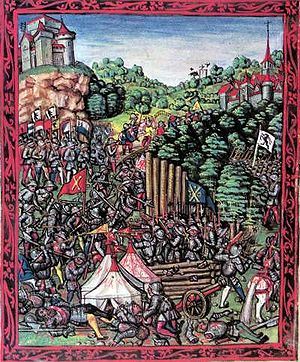Battle of Frastanz
| date | April 20, 1499 |
|---|---|
| place | Frastanz in Vorarlberg , Austria |
| output | Victory of the Confederation |
| Parties to the conflict | |
|---|---|
|
Old Confederation :
Zurich Bern Lucerne Uri Schwyz Unterwalden Glarus Zug Solothurn Freiburg |
|
| Commander | |
| Troop strength | |
| approx. 8000 knights and mercenaries in the camp, approx. 1500 Tyrolean miners on the Royaberg | approx. 9000 confederates and allies from eastern Switzerland and the three leagues. |
| losses | |
|
approx. 3000 dead |
approx. 11 dead, 60 wounded |
Triesen · Hard · Bruderholz · Hallau · Schwaderloh · Frastanz · Calven · Dornach
The Battle of Frastanz on April 20, 1499 was fought during the Swabian War between troops of the Swiss Confederation and the Swabian Federation at Frastanz near Feldkirch .
In March 1499, as part of the Swabian War, troops of the Swabian Confederation undertook a raid across the Rhine into the federal dominions of the Rhine Valley and Sax-Forstegg . The Confederates, together with the allied three leagues , therefore gathered around 9,000 men near Azmoos , which is why the mainly Habsburg troops from Tyrol and Upper Austria retreated across the Rhine again. They moved to fortified positions behind the town of Feldkirch , where they used a letzi to block the Swiss Confederates' way to the valley of the Montafon behind at the Illklamm .
The confederates first began to siege Gutenberg Castle , which they were unable to take due to a lack of artillery. After investigations by the experienced mercenary leader Heini Wolleb from Uri , it was decided to attack the Letzi near Frastanz. A hopeless attack on the strong front was not planned, but a bypass via the Royasattel above Galmist and Fellengatter in order to invade the less protected flank of the Letzi .
To this end, the federal armed forces were split into three parts. 2000 fighters selected by Wolleb were to first clear the Royaberg of the Habsburg troops. The main force of about 5000 men under the command of Ulrich von Hohensax was supposed to move over the western slope of the Royaberg through the forest to Fellengatter. The Graubünden contingent of around 1,600 men was to remain behind to bind the Feldkirch garrison .
The attack plan seemed to have failed at first, as Wolleb's troops at the Vorderälpele were stopped by around 300 Habsburg riflemen and 1,500 soldiers from Tyrolean miners. After a fierce battle, however, the Tyroleans were overcome and driven down the mountainside, where they were wiped out by the main federal powers. The two contingents were reunited at Fellengatter . The troops of the Swabian League marched towards the Confederates on the Samina stream and brought their powerful artillery into position. Since the Confederates initially seemed to hesitate in their inflated position in the face of the enemy ready to fight, the Swabians attacked. However, the cavalry had to stay behind, as they were mostly across the Ill . After the whole army was in smoke after the firing of the Swabian artillery, the Confederates attacked and, thanks to their superior philistines, overcame the battle line with their gang of violence . The desperately retreating Swabian and Habsburg mercenaries were slaughtered or drowned on the banks of the Ill. The confederates only lost around 11 men while over 3,000 men in the Swabian Federation lost their lives.
The Battle of Frastanz was next to the Battle of Dornach one of the bloodiest and most important decisive battles of the Swabian War. The Confederates lost the well-known mercenary leader Heini Wolleb from Uri, whose daring strategy the victory was ultimately due to.
literature
- Hans Rudolf Kurz: Swiss battles . Second, revised and expanded edition. Francke, Bern 1977. pp. 165-171. ISBN 3-7720-1369-4
- Karl Heinz Burmeister : The Battle of Frastanz on April 20, 1499 . In: Quarterly magazine of the Rheticus Society . Volume 21, issue 1. Feldkirch 1999, ISBN 3-900866-62-7 , p. 113–125 ( full text available as PDF in the holdings of the Lake Constance libraries).

